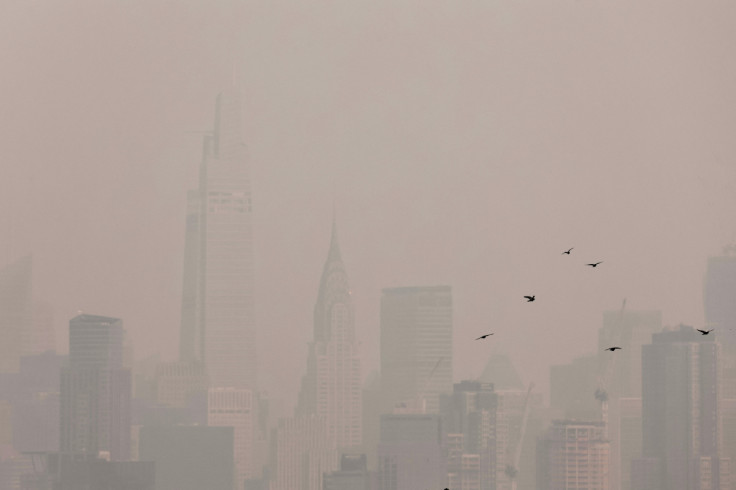Canadian Wildfire Smoke Has Reached Europe, Satellite Imagery Shows

KEY POINTS
- Satellite data show the Canadian wildfire smoke crossing the Atlantic onto Europe
- The U.K.'s weather service said the smoke may make for 'vivid sunrises and sunsets'
- The wildfires are believed to have released record carbon emissions
The smoke from Canadian wildfires has already reached Europe, and satellites have captured how the smoke and soot crossed the Atlantic.
Parts of Canada and even the U.S. have been shrouded in wildfire smoke as the battle against the blazes continues in Canada. Now, it appears the thick smoke has crossed not just beyond borders but over waters, too, with the smoke reaching Europe as well.
An image captured by the Moderate Resolution Imaging Spectroradiometer (MODIS) instrument on NASA's Terra satellite Monday morning shows the thick of the smoke crossing the Atlantic Ocean and drifting over to Portugal and Spain.
Smoke from wildland fires in Canada has now reached Europe.@nasa’s Terra satellite captured this image of smoke drifting across the Atlantic Ocean and over Portugal and Spain on June 26, 2023. https://t.co/cwQSkmysyH pic.twitter.com/R7pNTQ3mPh
— NASA Earth (@NASAEarth) June 27, 2023
According to NASA Earth Observatory, the smoke has also reached other European countries. It also shared imagery from data gathered by the GEOS forward processing model, showing a plume of soot from the wildfires crossing over the Atlantic Ocean.
This map shows the density of black carbon particles – or soot – from North America across over 2,000 miles of the Atlantic Ocean.
— NASA Earth (@NASAEarth) June 27, 2023
The data come from @NASAGoddard’s GEOS-FP model that combines satellite, aircraft, and ground-based meteorological data. https://t.co/cwQSkmysyH pic.twitter.com/y97FIJbTMR
Various locations in Europe already started seeing hazy skies, though on Monday the air quality wasn't as bad as the ones experienced in some places in the U.S. and Canada.
"Whilst the smoke is high up in the atmosphere, it may make for some vivid sunrises and sunsets in the next few days," the U.K.'s national weather service, the Met Office, said in a tweet. It also shared satellite imagery showing the smoke reaching Europe on Monday.
Smoke from wildfires in Canada has drifted right across the Atlantic Ocean and is now evident on satellite imagery across western Europe
— Met Office (@metoffice) June 26, 2023
🌅 Whilst the smoke is high up in the atmosphere, it may make for some vivid sunrises and sunsets in the next few days pic.twitter.com/VSBPx0jH5n
According to the Copernicus Atmosphere Monitoring Service (CAMS), the "main volume" of the smoke reached Western Europe on Monday and is expected to continue to move further east until Thursday.
The wildfires in eastern and western Canada have reportedly emitted a record amount of planet-warming carbon. This makes the annual emissions from fires the largest in Canada since the satellite monitoring started back in 2003. That's with the year just about halfway through and the fires still raging on.
So far, the wildfires have reportedly released more carbon dioxide in the first half of 2023 compared to any other full year on record.
As of Monday, more than 490 fires were still active across the country, 257 of which are considered to be burning "out of control," according to CAMS. British Columbia, for instance, has 103 active wildfires, while Alberta has 83 and Saskatchewan has 32.
The daily wildfire intensity is said to be "well above" the 2003 to 2022 values for these places at this time of the year.
"In British Colombia and Saskatchewan, the estimated carbon emissions for May-June are already the highest on record, while in Alberta the emissions over the two-month period, estimated at just over 20 megatons, are the highest since the extreme fires experienced in May 2019, in which over 880,000 hectares were burned," noted CAMS.
Last Friday, Canada and the U.S. signed an arrangement to strengthen the countries' cooperation against worsening wildfires "in the face of this climate change-driven threat." This would support "a more sufficient exchange" of resources to suppress wildfires across borders and facilitate the sharing of vital information in wildfire land management.
© Copyright IBTimes 2024. All rights reserved.






















